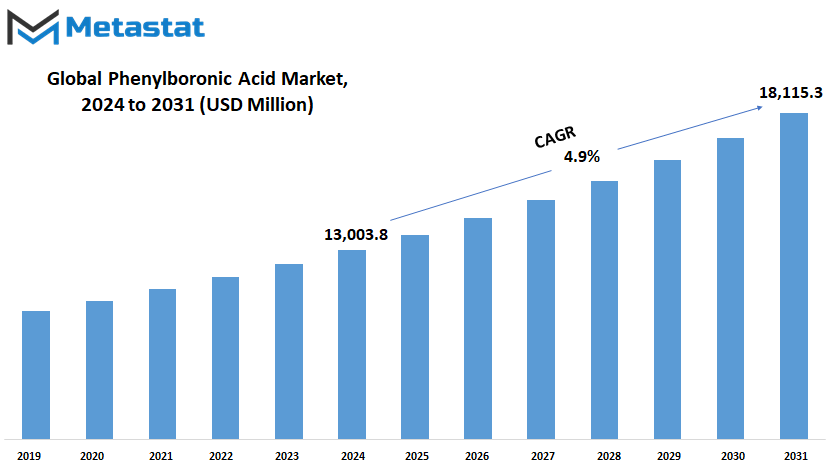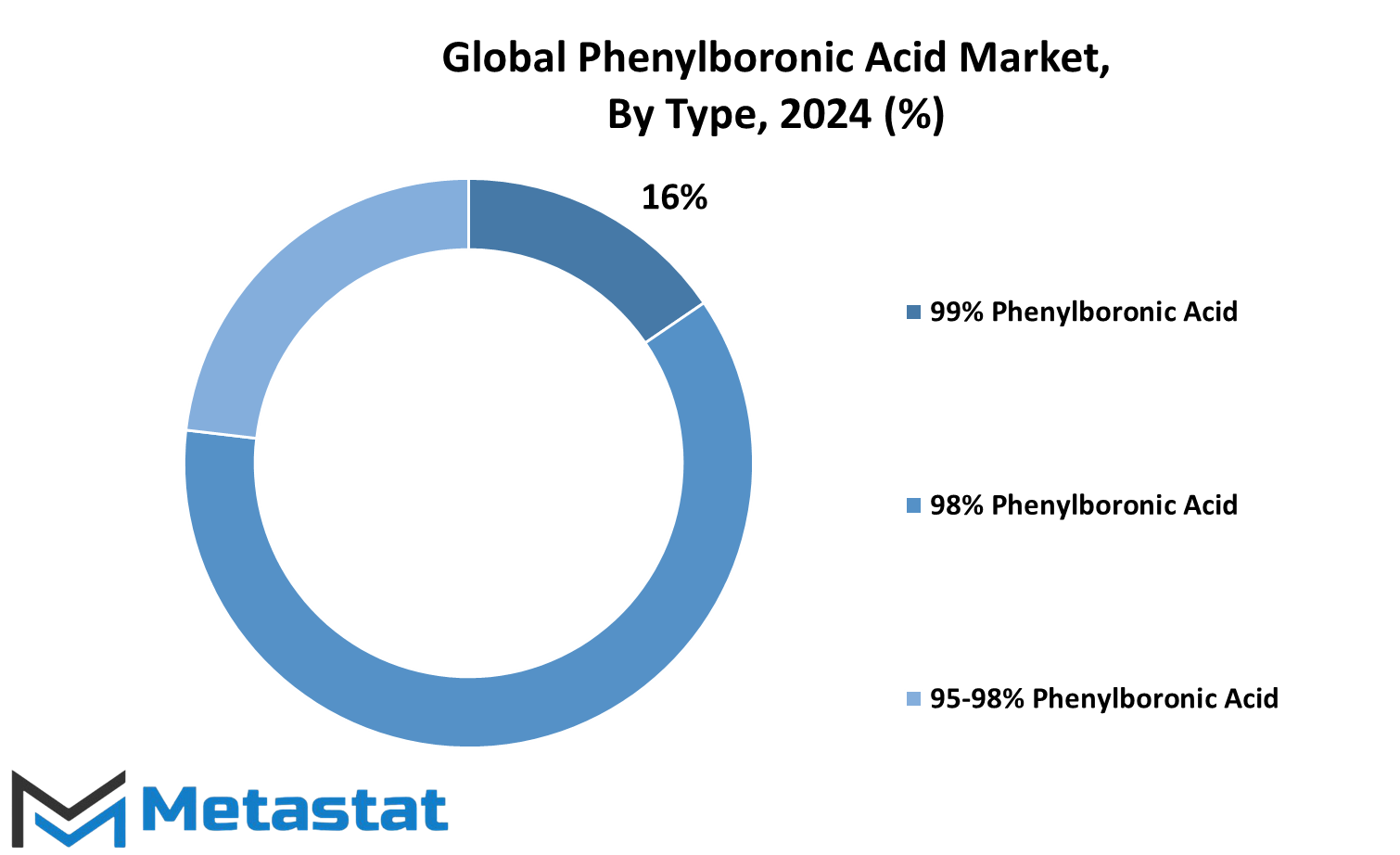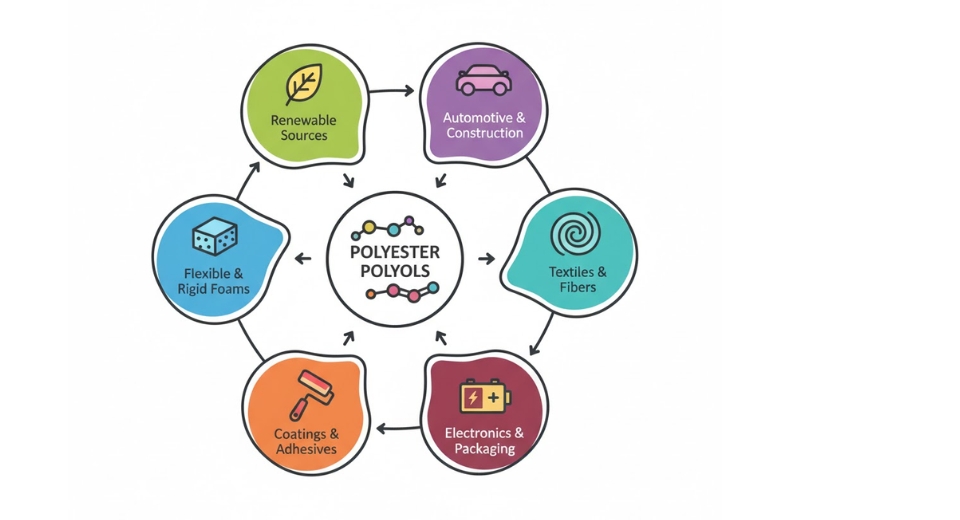MARKET OVERVIEW
The global Phenylboronic Acid market currently attracts the interest of all stakeholders in the specialty chemical industry. As a pivotal compound, applications vary in such fields as pharmaceuticals, organic synthesis, sensing, and material sciences. It finds its great usefulness in organic chemistry and biochemistry due to versatility in the reactivity of the compound and the forming of stable complexes with diols. Continuous research by research laboratories, chemical manufacturers, and various industries at the end-user stage is enlarging the usability of phenylboronic acid, hence increasing the market potential of the compound.
The diverse application spectrum of the compound shapes the market dynamics of Global Phenylboronic Acid. It is also one of the most useful compounds in drug development, especially in the synthesis of enzyme inhibitors and as an intermediate in the synthesis of pharmaceuticals. Of particular interest in recent years is the application of phenylboronic acid in targeted drug delivery systems, especially in cancer treatment. This is further extended by the unique ability of the compound to bind selectively with some biomolecules, enabling the development of new diagnostic tools and targeted therapies. As medicinal chemistry continues to evolve, further new therapeutic uses are foreseen to emerge and take the market even further.
Aside from pharmaceutical uses, organic synthesis applications also drive the Global Phenylboronic Acid market. It also acts as a critical reagent in Suzuki coupling reactions, which are considered indispensable in the synthesis of biaryl compounds. This is the general structure of many agrochemicals, pharmaceuticals, and polymers; hence, the demand for these products is increasing, and the need for this intermediate in chemical synthesis will also continue to surge accordingly. Researchers and chemical engineers are constantly on the lookout for new methodologies involving the use of phenylboronic acid that could prove to be more effective and less expensive, thereby changing the dynamics of the market’s course in the future.
Further, the development in material science has also been a driving aspect of this market. Derivatives of phenylboronic acid are used for developing new types of materials that have unique properties, such as responsiveness against changes of pH or of certain biological markers. These materials have possible applications in the development of intelligent sensors and diagnostic tools, so vital in health care, monitoring of the environment, and a variety of industrial processes. Such fast-expanding research on these kinds of materials is going to lead to the growth of the Global Phenylboronic Acid market due to increasing demand for newer technologies in these sectors.
The regulatory framework is another crucial factor in the development of the market. Much like other chemical substances, the manufacturing, selling, and utilization of this phenylboronic acid come under the ambit of various regional regulatory standards that must be complied with. Thus, any changes in the regulatory policies, especially those related to the environmental safety and health standards, can be expected to affect the Global Phenylboronic Acid market.
Combination of currently commercialized applications and emerging opportunities will continue to be applied in the market. Considering the intensification of research and development activities, there is a considerable probability that phenylboronic acid may find new uses, hence broadening the base for its market. The industry will also be conditioned by the growth of emphasis on sustainability as companies seek greener methods of producing and using phenylboronic acid. The given trends are indicative of this factor and, at the same time, show that though the Global Phenylboronic Acid market is niche at this point in time, it has huge potential for expansion and innovativeness.
Global Phenylboronic Acid market is estimated to reach $18,115.3 Million by 2031; growing at a CAGR of 4.9% from 2024 to 2031.

GROWTH FACTORS
The global phenylboronic acid market will expand very positively with a couple of key factors. Of these key factors, there stands growing leveled usage of phenylboronic acid in pharmaceuticals. Currently, the compound has found its heightened value due to its utility in boron-containing drugs, which possess established typical therapeutic properties. Adding boron to drug molecules elevates their potency and specificity. Therefore, it is an important active component in new pharmaceuticals. An upward trend in the pharmaceutical market will further increase this market.
Another strong driver for phenylboronic acid is in demand for the said compound for use in Suzuki-Miyaura cross-coupling reactions. These reactions are building blocks for complex organic synthesis, which in turn provides materials for many areas, such as materials science and organic electronics. In light of increasing demands for sophisticated chemical products, demand for this compound used in such processes would likely increase.
Even with such positive growth drivers, the market does not lack challenges. The actual cost of production and complex procedures that are used during synthesis make it difficult to expand the market further. In most cases, the synthesis of phenylboronic acid entails very complicated procedures that require high levels of resources, meaning the overall cost is increased. Moreover, phenylboronic acid is sensitive to moisture and air. This sensitivity makes storage difficult and increases handling costs that could slow down market growth. The market for phenylboronic acids is supposed to experience a surge in the foreseeable future due to their rising applications in emerging technologies.
A highly promising area here would encompass biosensors for monitoring glucose levels and diagnostic devices. The requirements for precise and timely glucose monitoring by patients with diabetes are rapidly growing, and these applications are becoming increasingly more relevant today. Phenylboronic acid is so very important to the functionality of these biosensors that its application in this sector can be said to be one of the key opportunities for future growth. Although the Global Phenylboronic Acid market has indeed had to face certain challenges as well, such as high production cost and sensitivity in handling, growth potential remains very strong in the market. With increasing utilization within pharmaceuticals and chemical synthesis, as well as recent applications within the field of biosensors, the market is highly likely to move forward in the near years.
MARKET SEGMENTATION
By Type
The Global Phenylboronic Acid Market is expected to observe high growth in the coming years. It will be accompanied by growing demand in several sectors to fuel the market. Phenylboronic acid is a chemical compound that finds application in the fields of pharmaceuticals, material science, and as an organic synthesis reagent. Its varied applications have made it an important substance in several industries.
This has allowed us to predict the future market for phenylboronic acid. The market segmentation is supposed to be primarily on type, based on purity levels in this product. There are three basic types of the product differentiated purely by their purity levels: 99% Phenylboronic Acid, 98% Phenylboronic Acid, and 95-98% Phenylboronic Acid.
The highest purity level, 99% Phenylboronic Acid, is expected to be the most in-demand one. This form has a very high level of purity, which is important for applications that require accuracy-high accuracy in pharmaceutical formulations, and also in advanced materials research and development. High purity ensures that such a compound works effectively within processes or uses with imitations of impurities; minor impurities in other reactions may undermine the end results.
98% Phenylboronic Acid will also be in high demand. This chemical is a middle-of-the road compromise between cost and performance, useful to many applications where ultra-high purity is not so important. It will see steady demand by industries requiring reliable but not too costly materials.
The 95-98% Phenylboronic Acid segment is expected to find applications that are more cost sensitive. Although it possesses slightly less purity than other types, it can still provide sufficient performance for most purposes. This segment will be very popular in bulk applications where cost efficiency is a key concern.
Different degrees of purity within the Global Phenylboronic Acid market will express specific requirements for the market as a whole. Higher demand in various fields will, in turn, lead to further specialization and innovation as well as enhancement of the production techniques and applications that are driving future growth. Segmentation by type serves to meet different requirements with high-end solutions alongside cost-effective solutions to meet further growing requirements for this market.

By Application
The Global Phenylboronic Acid market is developing fast with this compound's wide-scale use in different industries. Considered important in chemical synthesis and material science, this chemical product is gaining much prominence in pharma intermediates, liquid crystal materials, and many other industries. As we gaze to the future, the outlook of this market remains very promising for growth and development.
Phenylboronic acid, a key intermediate in the pharmaceutical industry, is widely used to create novel drugs. The chemical properties that it possesses have made this compound one of the best building blocks in the synthesis of drugs. Market Overview The market for this product will be growing significantly because more patients are now demanding these new medications and expensive treatments. Increasing drug development and the demand for more powerful drugs are factors that will drive the demand of phenylboronic acid in pharmaceutical manufacturing as a critical component.
Other promising applications can be seen in the use of phenylboronic acid in liquid crystals. Liquid crystals are an essential constituent part of any electronic display and equipment such as televisions, computer monitors, and mobile phones. As the progress on the technological front coupled with increasing needs for display technology, there is expected to be a good demand for high-quality liquid crystal materials. In turn, there is also, therefore, a likelihood of demand for phenylboronic acid, which is a core ingredient in the synthesis process of such materials.
Other uses of phenylboronic acid are in industrial and research fields. This acid is used for various chemical derivations, contributing to the development of new materials with numerous properties. Due to industries' demand for innovative applications and materials, these industries will further create more applications for phenylboronic acid in the future.
Exactly, the future of the Global Phenylboronic Acid market looks bright. Given the ongoing growth in the pharma sector, the advancement of technology in display materials, and the high industrial applications, this market will also set a solid growth track. Companies engaged in the production and application of phenylboronic acid would also look for this trend since the compound remains a primary chemical in many fields. With the passage of time and emergence of novel applications, and thus technological advancement, the role of phenylboronic acid in innovation and industrial needs is only destined to go on increasing.
|
Report Coverage |
Details |
|
Forecast Period |
2024-2031 |
|
Market Size in 2024 |
$13,003.8 million |
|
Market Size by 2031 |
$18,115.3 Million |
|
Growth Rate from 2024 to 2031 |
4.9% |
|
Base Year |
2022 |
|
Regions Covered |
North America, Europe, Asia-Pacific Green, South America, Middle East & Africa |
REGIONAL ANALYSIS
In the international Phenylboronic Acid market assessment, it shows that a strict regional analysis gives a glimpse of its future outlook. In fact, this market has been segmented into several key geographical areas with unique opportunities and challenges arising from each region.
The North American Phenylboronic Acid market consists of countries in the U.S., Canada, and Mexico, which are also considered to be on the world map. The factors that make it one of the leading ones are the great research capabilities and the strong industrial base of the region. The U.S. is one of the most significant contributors because there is a substantial investment in chemical research and development here. These investments fuel the innovation in the use of phenylboronic acid. Canada, positioned very crucially, contributes to the growth of the market by virtue of its research institutions, while, on the other hand, Mexico's growing manufacturing sector fills potential for it.
The European market is a safe and advanced place for phenylboronic acid because of strict regulatory frameworks and much advanced standards on chemical products. Germany and the UK are major contributors to the growth of the market in this region, with a developed chemical industry and current focus on the technological contributions. France and Italy have also been significant contributors due to their active participation in both chemical and pharmaceutical industries. Asia-Pacific is the second mainstream market for Phenylboronic Acid in the global arena. India, China, Japan, South Korea, and all other nations of Asia-Pacific are potential markets in this regard. Such markets lead the list, and production from China and India is mostly leading in terms of manufacturing capabilities and an upsurge in the market due to their large-scale industrial operations and demand for chemical products. Advancement in technology and high-quality chemical product manufacturing by Japan and South Korea further consolidate this market segment.
South America includes Brazil, Argentina, and other countries. They have an emerging market for phenylboronic acid. Brazil and Argentina have been increasingly industrialized with satisfactory infrastructures and hence hold good development prospects for phenylboronic acid. In this region, the economic fluctuations that have been reported and differences in the level of market development are disadvantages.
The Middle East and Africa, comprising GCC countries, Egypt, South Africa, and some other parts within this region, presents a diverse scenario in the market with regard to opportunities. Investments in the chemical industries of the GCC countries are pretty significant, thus furthering the expansion of market economies. Egypt and South Africa contribute their share in terms of the growing phases of industrial sectors with uplifts in chemical production abilities.
In conclusion, the future of the Phenylboronic Acid global market will be defined by characteristics and developments that are uniquely regional, hence marking it as a dynamic playing field for investors and industry observers.
COMPETITIVE PLAYERS
The Global Phenylboronic Acid market is set to experience significant shifts as companies continue to innovate and compete within this specialized sector. Leading players in the market, such as Hebei Maison Chemical, Optima Chemical, and Beijing Purechem, are pivotal in shaping the future of phenylboronic acid production and supply. These companies are not only working on improving the quality and efficiency of their products but are also investing in research and development to enhance their competitive edge.
Jinan Finer Chemical and Midori Kagaku are also crucial contributors to this market. They focus on developing new applications for phenylboronic acid, which could potentially open new avenues for growth and expansion. As industries increasingly seek to use phenylboronic acid in advanced chemical reactions and materials, these companies will likely be at the forefront of these developments.
In addition, UIV Chem and Denisco are making strides in refining their manufacturing processes. Their efforts to optimize production efficiency and reduce costs will play a significant role in their ability to compete effectively. Meanwhile, Beijing Golden Olive and Alfa Aesar are focusing on maintaining high-quality standards and ensuring that their products meet stringent regulatory requirements. This commitment to quality is essential as the market evolves and demands more sophisticated solutions.
Companies like Cole-Parmer Instrument Company, LLC., Sigma-Aldrich, and TCI America are renowned for their extensive catalogs and reliable supply chains. They are well-positioned to leverage their established market presence to capture a larger share of the Global Phenylboronic Acid market. Their ability to provide a wide range of products and services will continue to be a strong competitive advantage.
Combi-Blocks, Ark Pharm, and Fluorochem are also making notable contributions to the market. These companies are exploring innovative uses for phenylboronic acid in various fields, including pharmaceuticals and materials science. Their research efforts and technological advancements are likely to drive new market opportunities.
Apollo Scientific, Cayman Chemical, Chem-Impex International, Matrix Scientific, and Oakwood Products further exemplify the diversity within the market. Each of these companies brings unique strengths and expertise to the table, contributing to a dynamic and competitive landscape.
As the Global Phenylboronic Acid market progresses, these key players will play a crucial role in determining its trajectory. Their ongoing efforts in research, development, and production will shape the future of the market, driving innovation and growth. The competition among these companies will likely result in more advanced and efficient solutions, ultimately benefiting the broader industry and its diverse applications.
Phenylboronic Acid Market Key Segments:
By Type
- 99% Phenylboronic Acid
- 98% Phenylboronic Acid
- 95-98% Phenylboronic Acid
By Application
- Pharmaceutical Intermediates
- Liquid Crystal Material
- Others
Key Global Phenylboronic Acid Industry Players
- Hebei Maison Chemical
- Optima Chemical
- Beijing Purechem
- Jinan Finer Chemical
- Midori Kagaku
- UIV Chem
- Denisco
- Beijing Golden Olive
- Alfa Aesar
- Cole-Parmer Instrument Company, LLC.
- Sigma-Aldrich
- TCI America
- Combi-Blocks
- Ark Pharm
- Fluorochem
WHAT REPORT PROVIDES
- Full in-depth analysis of the parent Industry
- Important changes in market and its dynamics
- Segmentation details of the market
- Former, on-going, and projected market analysis in terms of volume and value
- Assessment of niche industry developments
- Market share analysis
- Key strategies of major players
- Emerging segments and regional growth potential








 US: +1 3023308252
US: +1 3023308252






